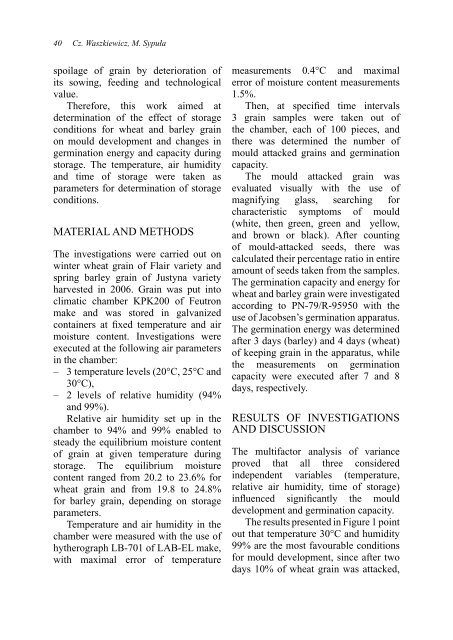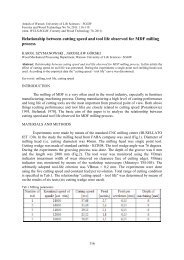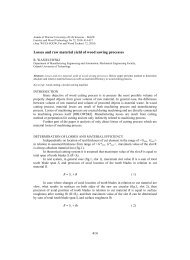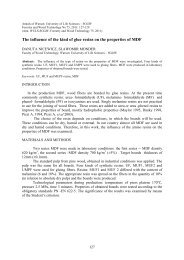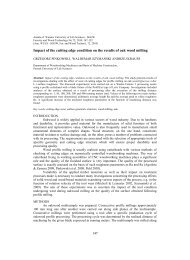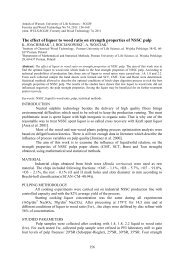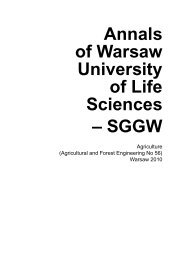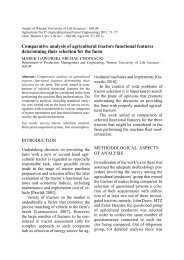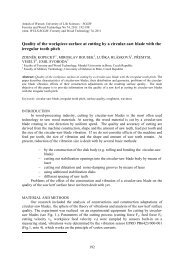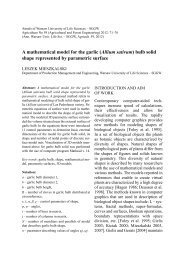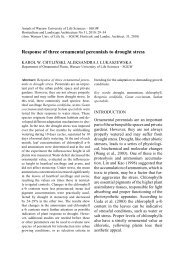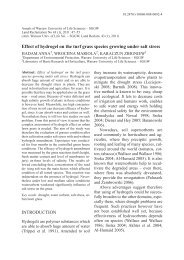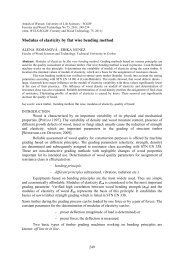Annals of Warsaw University of Life Sciences - SGGW.
Annals of Warsaw University of Life Sciences - SGGW.
Annals of Warsaw University of Life Sciences - SGGW.
You also want an ePaper? Increase the reach of your titles
YUMPU automatically turns print PDFs into web optimized ePapers that Google loves.
40 Cz. Waszkiewicz, M. Sypułaspoilage <strong>of</strong> grain by deterioration <strong>of</strong>its sowing, feeding and technologicalvalue.Therefore, this work aimed atdetermination <strong>of</strong> the effect <strong>of</strong> storageconditions for wheat and barley grainon mould development and changes ingermination energy and capacity duringstorage. The temperature, air humidityand time <strong>of</strong> storage were taken asparameters for determination <strong>of</strong> storageconditions.MATERIAL AND METHODSThe investigations were carried out onwinter wheat grain <strong>of</strong> Flair variety andspring barley grain <strong>of</strong> Justyna varietyharvested in 2006. Grain was put intoclimatic chamber KPK200 <strong>of</strong> Feutronmake and was stored in galvanizedcontainers at fixed temperature and airmoisture content. Investigations wereexecuted at the following air parametersin the chamber:––3 temperature levels (20°C, 25°C and30°C),2 levels <strong>of</strong> relative humidity (94%and 99%).Relative air humidity set up in thechamber to 94% and 99% enabled tosteady the equilibrium moisture content<strong>of</strong> grain at given temperature duringstorage. The equilibrium moisturecontent ranged from 20.2 to 23.6% forwheat grain and from 19.8 to 24.8%for barley grain, depending on storageparameters.Temperature and air humidity in thechamber were measured with the use <strong>of</strong>hytherograph LB-701 <strong>of</strong> LAB-EL make,with maximal error <strong>of</strong> temperaturemeasurements 0.4°C and maximalerror <strong>of</strong> moisture content measurements1.5%.Then, at specified time intervals3 grain samples were taken out <strong>of</strong>the chamber, each <strong>of</strong> 100 pieces, andthere was determined the number <strong>of</strong>mould attacked grains and germinationcapacity.The mould attacked grain wasevaluated visually with the use <strong>of</strong>magnifying glass, searching forcharacteristic symptoms <strong>of</strong> mould(white, then green, green and yellow,and brown or black). After counting<strong>of</strong> mould-attacked seeds, there wascalculated their percentage ratio in entireamount <strong>of</strong> seeds taken from the samples.The germination capacity and energy forwheat and barley grain were investigatedaccording to PN-79/R-95950 with theuse <strong>of</strong> Jacobsen’s germination apparatus.The germination energy was determinedafter 3 days (barley) and 4 days (wheat)<strong>of</strong> keeping grain in the apparatus, whilethe measurements on germinationcapacity were executed after 7 and 8days, respectively.RESULTS OF INVESTIGATIONSAND DISCUSSIONThe multifactor analysis <strong>of</strong> varianceproved that all three consideredindependent variables (temperature,relative air humidity, time <strong>of</strong> storage)influenced significantly the moulddevelopment and germination capacity.The results presented in Figure 1 pointout that temperature 30°C and humidity99% are the most favourable conditionsfor mould development, since after twodays 10% <strong>of</strong> wheat grain was attacked,


